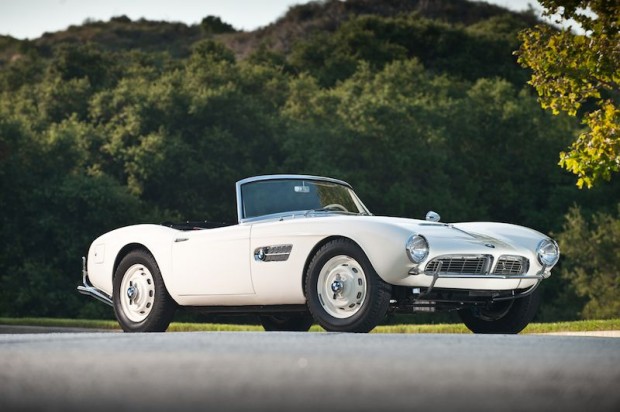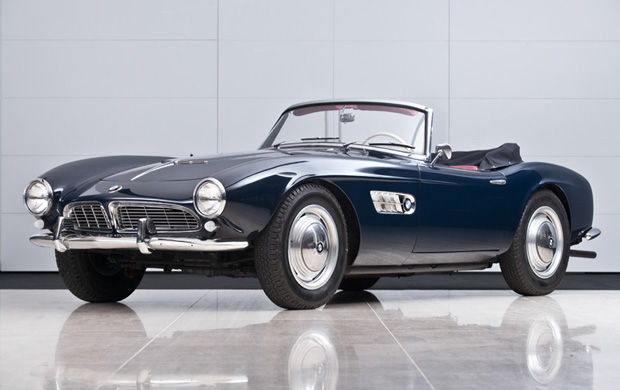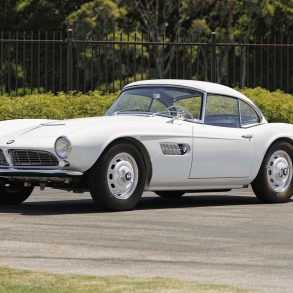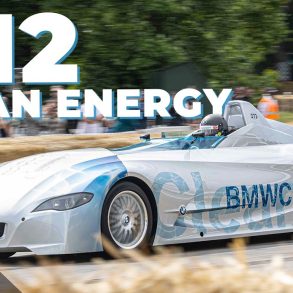Some cars are designed to get us from A to B, and nothing more. And then there are icons – cars that leave their mark, monumental creations of a certain era in the automotive world. The BMW 507 is most certainly not just a car. Even though the 507 was by no means a financial success, its place in automotive history will never be forgotten.
It was a car born essentially out of a need for a cheaper, alternative version of the Mercedes 300SL. The 507 was supposed to be the car that would close the gap between the cheap British MG roadsters and the pricier Porsche and Mercedes roadsters. But it turned out to be much more than an affordable 300SL.
The BMW 507 offered the best Bavaria had to offer. Stunning, flowing curves with an improved twin carburetor V8 kicking out 150 hp. It was pure roadster bliss from BMW that inspired not only the future Z8 but also other car manufacturers to copy the formula. Here is why the BMW 507 was one of the greatest iconic cars and simultaneously a less financially successful BMW creation.

Max Hoffman and the birth of the BMW 507
Not to be confused with the WW1 strategist Max Hoffmann, the Max Hoffman in the story of the BMW 507 was an Austrian born, US car importer in New York. Through his knowledge of the booming post-war American market, he made suggestions to European car manufacturers regarding the ideal car makes to target the US market. This way, Hoffman influenced the creation of the Mercedes 300SL and the Porsche Speedster. To compete with Mercedes, Porsche, and MG, Hoffman suggested to BMW that a roadster version of the BMW 501 and 502 saloons should be made.
Max Hoffman claimed he could sell enough BMW roadsters in the USA to make the project financially viable. BMW agreed to his suggestion and hired Albrecht Graf von Goertz to design the 507. Goertz was an independent industrial designer with expertise in designing everything from furniture to pens. The 507 was his first-ever entire car design project. This is how the story of the 507 began. It was revealed in the summer of 1955 in the Waldorf-Astoria hotel in New York City.
German Engineering and Design
The inward slanting split grill in the front and the voluptuous curves made the 507’s looks almost shark-like. The design was ahead of its time and fueled several future generations of BMW, including the desired modern collectors hot pick, the BMW Z8. Even though Albrecht Graf von Goertz did a spectacular job designing the 507, he would not work with BMW until the 1980s.
Mechanically, the 507 shared a lot of components with the BMW 502 and 503, including the engine. The lightweight aluminum pushrod-operated overhead valve V8 was equipped with two-barrel carburetors and a chain-driven oil pump.
The engine produced 150 horsepower with plenty of torque to pull through all the 4 gears of the manual transmission. Due to the all-aluminum body and the lightweight V8, the weight of the 507 was just over 1200 kg. The performance was more than adequate for its time. Reaching a top speed of 200km/h (125mph), with 100km/h (62mph) coming up in 11 seconds. The wheelbase was short at 2480mm but due to its curvaceous design and bodywork, the 507 looked elegant and sporty at the same time. This almost sounds like a description of a modern BMW design formula, sporty elegance.
Production of the BMW 507 Starts and Financial Headaches Emerge
The production started in 1956 and right away, BMW realized that making a full aluminum body 507 was not going to be sold for $5000 as Max Hoffman had suggested.
The initial price of the Series I BMW 507 was $9000 which in today’s money, adjusted for inflation would have been somewhere between $80-90,000. At this price, it just was not being sold as a cheaper alternative to the expensive Mercedes 300SL. But despite BMW wanting to provide the 507 in that $5000 price range, the production costs were simply too high.
Series II of the 507, which is the most sought after today was introduced in the summer of 1957. The second series featured a revised design, mainly focused on the interior. The dashboard was pushed deeper, which gave the seats a bit more back and forth adjustment options and they also included a rear parcel shelf. The series II also came with an increase in the price of $11,000.

The price increase of the 507 Series II was ultimately the main factor leading to the roadster’s production ceasing. By narrowing the niche sports car market to only wealthy clientele, BMW could not sustain the production of the 507. On production ceasing in December 1959, only 252 BMW 507’s were ever made, which was far away from the expected 5000 per year. This also means the BMW 507 is a true rarity.
The Car that Revived BMW Sporting Image
Although the 507 never achieved any grand motorsport titles, it was still used by racing legends like Hans Stuck. Hans was known as a dominating German hill climb racing driver, often referred to as “Bergkönig” or “King of the Mountains”.

He had a short run with a modified BMW 507 and collected some hill climbing wins with it, but never any major titles. His 507 was later bought by none other than Elvis Presley which we will touch upon later.
Another famous owner of the 507 was the Formula 1 legend, John Surtees. Surtees remains the only person to have won world championships both on 4 wheels and on 2.

A truly remarkable driver got the BMW 507 as a gift by Count Augusta when he won the world championship on an MV Augusta motorcycle. John Surtees kept his 507 till the end of his life in 2017. The car went on auction a year after his death and sold for 4 million pounds. This was the highest bid for a BMW 507 ever and the fact that it was owned by a major motorsport legend played a huge part.
The 507 remains to be the car that revived the sporting essence of BMW. The company was still not fully recovered after the second world war and even though the 507 was a financial headache, it still brought BMW back to life in the eyes of consumers.
507 – The Car of Choice for Elvis Presley
One of the most notable owners of not one, but two BMW 507s was Elvis Presley.
The king of rock and roll bought the 507’s while serving military duty in Germany. One of the 507s he bought was the one driven by the before mentioned “King of the Hill” Hans Stuck. When Stuck stopped racing with the 507, a car dealer in Frankfurt bought it with a refurbished engine and gearbox. At the time, the 23-year-old Presley opted for a test drive and bought it immediately. Because the car was equipped with military license plates, which changed every year, it became extremely difficult to trace in the later period.
Presley repainted it from white to red when it was imported into the USA (he had to constantly clean the prints of his fans’ lipstick from the white car).
For many years, no one knew the exact serial number of this car and whether Presley actually imported it into the US. It was only when they found out that Presley’s car had previously been driven by the famous German racer Hans Stuck at various competitions that the hunt for Presley’s car icon began again.
Stuck’s records revealed that the car with the serial number 70079 and registration number M-JX-800 won several mountain races in Germany, Austria, and Switzerland. It was this car that BMW exhibited at the Frankfurt Motor Show in 1957, after which it played the role of a journalist test car.
Both the 507s that Presley owned were in fact imported into the US. The one previously owned by Stuck was sold to Alabama disc jockey Tommy Charles. He replaced the engine with a Chevrolet V8 and did several other modifications. The second one (chassis # 70192) was gifted to the actress Ursula Andress. She was a good friend of Presley and a co-star in the 1963 movie “Fun in Acapulco”. This 507 also underwent serious modifications, the most notable being a Ford V8 engine. This 507 was later bought by George Barris who restored it to its original state.

The 507 owned by Hans Stuck and Elvis Presley was acquired by BMW Classic in 2014. When they started working on restoring the 507, they had a difficult task ahead of them. The car did not have the original engine and transmission, the rear axle was also not original and rust attacked the bottom of the car.

BMW made some components and individual elements like door handles, wiper console with the help of a 3D printer. They have also recreated the center console, matched the leather upholstery with the one in the original photos, and also found a real 3.2-liter V8 engine. They restored it with the help of spare parts provided by BMW. The legendary 507 with an amazing story was home, back where it belonged, looking like it once did.
The result of their work is one of the most exclusive vintage cars that BMW ever worked on. It was officially unveiled at the 2016 Concours d’Elegance in Pebble Beach, California.

A Piece of Art, an Automotive Poem
After the first presentation for US dealers in New York in July 1955, the 507 was presented to the public at the Frankfurt Auto Show two months later.
Media called the 507 “undoubtedly the showpiece of the entire exhibition” and further: “The 507 Touring sports car is a poem in itself, with which BMW will undoubtedly achieve great success.”
Many media celebrated the new BMW. Nevertheless, the 507 found far too few buyers, as the number proves. Its price in Germany was lower than that of the 300 SL. But a 507 was still out of the price range of its prospective clientele.
The 507, compared with the Mercedes 300 SL, was technically unspectacular. Mercedes overshadowed the 150 hp BMW with a 215 hp engine that featured innovative injection technology and better torque. Although the BMW was 90 kilograms lighter, it had a poorer power-to-weight ratio. In the performance comparison done by the Motor Revue at the beginning of 1958, the 507 clearly lost. For example, in a duel over a kilometer with a standing start, the 507 was left behind and took 3.3 seconds longer than the 300 SL Roadster (11.1 vs 8.8 seconds).
Compared to the sports car from Stuttgart, the chassis of the 507 was designed more for comfort. You see, the BMW 507 was never meant to dominate with power, but rather with comfort and enjoyment that a roadster brings. The 507 was by no means a slow and boring cruiser, it just wasn’t engineered to break speed records. BMW did however cause a sensation when it was first unveiled to its competitors at the 1955 Frankfurt Auto Show. A German automotive magazine Auto Motor and Sport stated that: “Some Mercedes officials can be seen here more often than in the Mercedes hall”.
A BMW 507 is a real gem. Today, the timeless design speaks for the open two-seater. Due to the low production numbers, the 507 holds its place as one of the most sought after Roadsters. Most of the 507s sold on auctions today go for at least 2 million US Dollars and future value is expected to grow. It is truly an automotive icon with a rich history and a great story. On paper, it is often called the car that almost caused the bankruptcy of BMW but in the eyes of BMW enthusiasts, it is the car that brought BMW back to life after the devastating war.

Looking back, many of the automotive icons today were not financial success stories. A clear example of that is also the AC Shelby Cobra. Automotive icons don’t become great by ticking the financial success box. They capture the imagination of their designers and provide joy to the consumers through the drive and appearance. The 507 certainly did that well and its iconic status is greatly deserved.















I first saw the BMW 507 in the paddock at the Sebring 12 Hour Race in 1957,and I at the tender age of 14 discovered intense lust for that beautiful auto which I never got to posses. It is still a premier work of 1950s automotive art to this day. I am now 77,and it looks like its not in my cards.
I was interested in a 507, and over a few years talked to 3 dealers. they all said ‘it’s $9k now, but next year it’ll be around $6k.’ how many potential buyers decided to wait for next year?